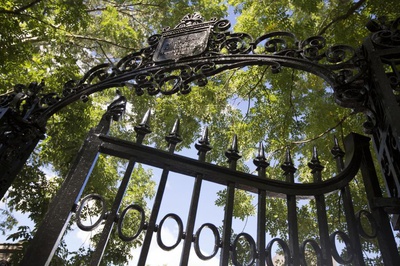
News
Harvard Researchers Develop AI-Driven Framework To Study Social Interactions, A Step Forward for Autism Research

News
Harvard Innovation Labs Announces 25 President’s Innovation Challenge Finalists

News
Graduate Student Council To Vote on Meeting Attendance Policy

News
Pop Hits and Politics: At Yardfest, Students Dance to Bedingfield and a Student Band Condemns Trump

News
Billionaire Investor Gerald Chan Under Scrutiny for Neglect of Historic Harvard Square Theater
The Bob Harrison Saga
What kind of coach does it take to create a successful basketball program at Harvard?
In the 64 years the game has been played here, a number of coaches have come and gone with a wide variety of styles, but only one, Edward A. Wachter, put together more than three winning seasons in a row. That was between 1921 and 1928.
The last man to take a shot at Crimson roundball before Tom Sanders came to the IAB was Robert W. Harrison. Harrison strung together three just-barely winning seasons during his five-year stay in Cambridge, but was fired in the spring of 1973 in a move that Athletic Director Robert Watson described as "in the best long-range interests of the program."
Harrison simply did not fit in at Harvard. He built a nine-year NBA career on toughness and a winning program while coach at Kenyon College on discipline and grueling workouts, but he could not transplant this attitude to Cambridge.
Harvard kids have "very low pain thresholds," Harrison told Crimson reporter Doug Schoen in 1972, and went on to relate a story about one ballplayer who started screaming when he put his leg in a whirlpool bath. This wasn't like players "in his day."
Harrison tried to employ a drill in practice that Indiana coach Bobby Knight, a notorious disciplinarian, has used on his Hoosiers. The team breaks up into two lines at opposite ends of the court, and on the coach's signal, the first man in each line has to dive to the floor to pick up a loose ball. The drill was quickly abandoned in the IAB when players complained of getting hurt.
Knight is able to get away with such drills, Harrison told Schoen, because he is able to go out and recruit the type of players he wants. Harvard coaches are shackled by Ivy League and school recruiting policies, and no one felt it more than Harrison.
"We can't travel to distant locations," Harrison lamented a month before his firing. "I never saw James Brown (one of two high school All-Americans from Washington, D.C. to play for Harrison's mediocre 1970-71 team) play before he came here, though I had heard of him."
During his ten-year reign as head coach at Kenyon, Harrison had much more control of the program. After heading East, he never could adjust to Harvard's parochial way of doing things in the Athletic department, and was never quite capable of pulling off the elusive goal of bringing big-time basketball to the antiquated IAB.
Even with four high school All-Americans on his 1971-1972 squad, the best Harrison could come up with was a 15-11 record.
But his flamboyant style, his volatile outbursts on and off the court and his fruitless search for, as he put it, a player who will "run through walls" for the good of the team, finally cost him his job.
Enter Tom Sanders, who accepted the Crimson coaching position May 15, 1973, saying then his goal was to "bring basketball into the proper persepctive as far as winning is concerned" for the Harvard ballplayers.
Want to keep up with breaking news? Subscribe to our email newsletter.
From Our Advertisers

Over 300+ courses at prestigious colleges and universities in the US and UK are at your disposal.

Where you should have gotten your protein since 1998.

Serve as a proctor for Harvard Summer School (HSS) students, either in the Secondary School Program (SSP), General Program (GP), or Pre-College Program.

With an increasingly competitive Law School admissions process, it's important to understand what makes an applicant stand out.

Welcome to your one-stop gifting destination for men and women—it's like your neighborhood holiday shop, but way cooler.

HUSL seeks to create and empower a community of students who are seeking pathways into the Sports Business Industry.
